With the amount of rain we can get in the spring, it’s no wonder that the systems in place to manage rain water can sometimes be overwhelmed. We just hope that water won’t make it into our homes.
What can you do though if the rain outside is starting to come in your home?
Groundwater entering through the foundation
As the ground soaks up all of that rain, it’s going to start looking for places to go – and unfortunately that means it may come into your basement! Foundation walls can actually hold a great deal of moisture, which will slowly increase the humidity in your basement area. For that reason, we strongly recommend monitoring humidity levels in your basement and setting up a dehumidifier if this proves to be an issue in your home. Because if the humidity is high, mold will soon follow!
For long term, or frequent water intrusion, you may need a more permanent solution. For wet basements, a basement waterproofing system may be necessary to prevent or divert groundwater that may want to come in through the foundation. A qualified basement waterproofing service will be able to design a system that will work for the unique needs of your home.
Driven rain coming in through windows or doors
Sometimes driven rain can blow at the perfect angle that it’s able to come in through windows or doors, but this shouldn’t happen. If you find yourself in a situation where rain water is coming in through the jam or sash, it’s a clear indication of an issue that needs to be addressed. Be sure to clean up any rain water that makes it inside and attempt to diagnose where precisely the moisture is entering from. In all likelihood, replacing weatherstripping will solve the problem, but a replacement of the door or window may ultimately be necessary depending on what needs to be fixed.
If you believe that moisture may have entered a wall, ceiling, or floor cavity, it is important to contact a professional mitigation and restoration firm as this hidden moisture could lead to mold issues in the future.
Roof leaks
Ceiling and roof leaks are most commonly caused by damaged, lifted, or missing shingles. While it’s important to prevent further interior damage by cleaning up the water and drying surfaces properly, so long as the roof damage exists, water will continue coming in.
We recommend taking a pair of binoculars and going outside to take a look at your roof. Look for any shingles that are missing, not laying flat, or don’t appear uniform. When looking at your roof, don’t limit your search to the area where you saw the leak inside, as moisture can travel along rafters and roof structures once it gets inside your home. The water mitigation firm assisting with the interior damage & drying should be able to refer a roofer that is able to thoroughly inspect the roof for damage and prepare a proposal to address the problem. They should also be able to assist in getting the roof tarped to prevent further moisture damage while waiting to proceed with these repairs.
While we hope you’re able to keep dry inside this spring, this should help you address some common moisture issues this rainy season may bring! As always, should you have any additional questions, or have a need of assistance with a moisture issue, please give us a call, we’re happy to help!
About Disaster Blaster
Disaster Blaster is an indoor environmental firm serving the Northeastern PA Area. We have been providing our local area with unparalleled water damage mitigation, basement waterproofing, mold remediation, asbestos abatement, radon mitigation, and fire / smoke restoration services for decades, and are proud to have been named The World’s Greatest Indoor Environmental Firm. For more about Disaster Blaster, as well as more helpful tips, please visit our website at: www.disasterblaster.com or call our office at (570) 963-1123.


